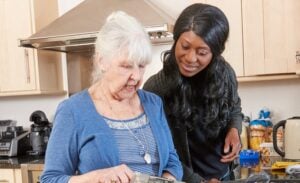The types of Parkinson’s and how to support a loved one
Tags
Parkinson's Care
What are the different types of Parkinson’s?
Parkinson’s disease (PD) is a neurological condition that causes trouble with movement. The condition is progressive – meaning it gets worse over time.
‘Parkinsonism’ is an umbrella term for a range of progressive conditions that cause motor symptoms (tremors, muscle rigidity and slow movement) – and includes PD itself. There are lots of types of Parkinsonism – some have known causes while others don’t, some are incredibly rare, and some we’re still learning about.
The three you’ll most likely come across are –
Idiopathic Parkinson’s, or PD
This is the most common Parkinsonism – in fact, it’s believed that 80%-85% of people diagnosed with parkinsonism have idiopathic Parkinson’s. “Idiopathic” means the cause of the condition is unknown.
Common symptoms include slowness of movement, muscle stiffness, and tremors.
While many refer to the condition as ‘Parkinson’s disease’, many people living with the condition, as well as the charity Parkinson’s UK prefer to call it ‘Parkinson’s’ or ‘PD’. This is because the word ‘disease’ is seen as too negative and suggests the condition is infectious, which it’s not.
Vascular parkinsonism
Vascular parkinsonism (sometimes referred to as arteriosclerotic parkinsonism) is a condition where the areas of the brain that control movement are damaged due to restricted blood supply. People who have experienced a mild stroke, or a series of mini strokes may develop this type of parkinsonism.
While it’s not the same condition as PD, it does share similar symptoms, such as difficulty with muscle control. Those living with the condition may also experience problems with mood and memory, and be susceptible to sleep disorders.
Drug-induced parkinsonism
Unfortunately some drugs have been found to cause parkinsonism. However unlike most types of parkinsonism, drug-induced parkinsonism very rarely progresses over time, and symptoms often stop once a person stops taking the drug.
Drugs that reduce dopamine levels in the brain to treat psychotic disorders are thought to be the biggest cause of this form of parkinsonism.
Caring for someone with Parkinson’s
Providing care and support to someone with PD or any form of Parkinsonism isn’t easy – whether they’ve recently been diagnosed, or living with their condition for a while.
Everyone’s Parkinson’s experience is unique – meaning not everyone will have the same symptoms, and you can’t predict in which order they’re likely to appear. They’ll likely be good days and bad days at each stage of the condition.
If you’re a family carer with limited caring experience, ensure you’re making the most of the healthcare professionals treating your loved one. For example, an Occupational Therapist will likely have some good practical advice on how to make the home more accessible, or be offer training on new ways to bathe, get dressed, or eat. You can usually contact an occupational therapist via your GP or local social services department.
Making the following changes to the home may be a good starting point too –
- Using non-slip mats in the bath or shower
- ensuring furniture and electrical cables aren’t posing a trip hazard
- Fixing loose or uneven floorboards, and securing rugs
- Installing grab rails
- Installing a coded ‘key safe’ so family members or carers can get into the house in an emergency
If you’re worried about managing their medication schedule it’s worth speaking to their GP, Parkinson’s Nurse, or a Pharmacist. They may be able to suggest a dosette box to help keep everything in order, or help you create a diary or chart of the different medicines, timings and doses that your loved one needs.

Recognising and managing non-motor symptoms
While Parkinsonism is most associated with movement, there are non-motor symptoms that it’s important to look out for while caring for a loved one. Depression is often part of PD due to the way the condition changes a person’s brain chemistry. In addition, a person may experience extreme grief or struggle to come to terms with their life-limiting condition. In fact, the Parkinson’s Foundation’s estimates as many as 50% of people diagnosed with PD will experience depression at some point.
Signs of depression can include persistent sadness, sudden mood swings, a loss of motivation, sudden change to hygiene or eating habits, poor attention, and difficulty sleeping. If you’re concerned about any of these signs, it’s worth gently checking in with your loved one, or seeking the support of a healthcare professional.
Urinary incontinence is another non-motor symptom to keep an eye out for. As a family caregiver you may notice that your loved one has a more frequent or urgent need to urinate, even if they haven’t been drinking a lot. It can be quite common in those with PD, and is usually easily treatable.
Some people will also lose their sense of smell (known as hyposmia). While this may not seem like a significant symptom on it’s own, it can have a impact on how much they’re eating. Smell often enhances our sense of taste and therefore hyposmia could lead to less interest in meal times.
Can someone with Parkinson’s live alone?
Many people with Parkinson’s live alone and are able to manage daily life well.
However as the condition progresses, involuntary movements and tremors may make some tasks like preparing meals more difficult, or potentially dangerous. If you’re worried about or have experienced some of the instances of the below it may be time to arrange some additional support –
- Falls or other injuries around the home
- Falling for scams or rogue doorstep traders
- Keeping the fridge and cupboards well-stocked and organised
- Managing finances
If you or your loved one are concerned about certain tasks, arranging live-in or hourly care could help provide peace of mind and help maintain a good quality of life. Even a short period of respite care can help ease some of the pressure of keeping a loved one safe 24/7.

What are the benefits of caring for Parkinson’s at home?
Staying in their own home can help people living with PD or other forms of Parkinsonism maintain a sense of normality, for as long as possible.
If additional support is required, an hourly or live-in carer can support with a wide range of daily living tasks and adjust the level of care being provided as your loved one’s needs change.
Home care professionals can help by –
- Providing personal care – assisting with bathing, toileting, and dressing
- Encouraging gentle movement and exercises to improve flexibility and posture, reduce freezing, and ease stiff muscles
- Taking on housework and running errands
- Staying social and taking part in activities safely
- Managing the weekly diary and keeping appointments, especially if cognitive decline is a concern
- preparing nutritious meals that contain whole grains, vegetables, fruits and protein-rich foods
- Providing specialist care for a range of Parkinsonism symptoms, such as sleep problems
This article is for informational purposes only and not to be taken as medical advice. For medical advice, always consult your GP.
Read more later life articles

12 summer safety tips for the elderly
It’s important for everyone to take care in hot weather – anyone can become unwell if they’re exposed to soaring temperatures. However, for older people

Live-in care vs other types of care
Live-in care vs other types of care Navigating elderly care options for a loved one is a significant decision. While care homes are a common

Defining Dignity in Later Life – Interview with Liz Lloyd
We talked to Liz Lloyd about personal and social perceptions of age, the challenges of identity, empowerment and choice.

The Challenges of Vegetarians and Vegans Living with Dementia
We talk to Amanda Woodvine about the challenges faced by older vegetarians and vegans receiving care. Read more here.

How much does live-in care cost?
How much does live-in care cost? Live-in care provides one-to-one support in the comfort of your loved one’s home, but how much does it cost?

How much does respite care cost?
Respite care offers short-term relief for primary carers, and the cost can vary widely depending on the type of care, location, and level of support